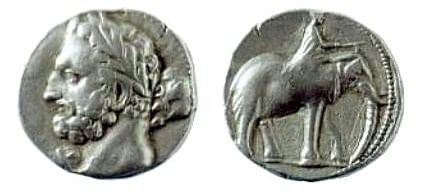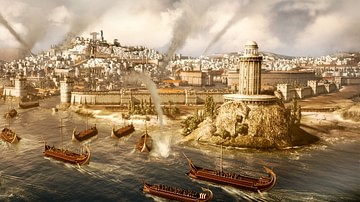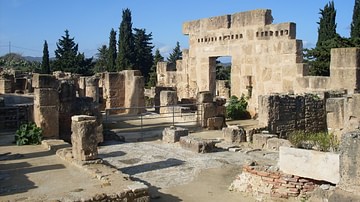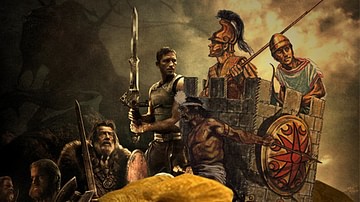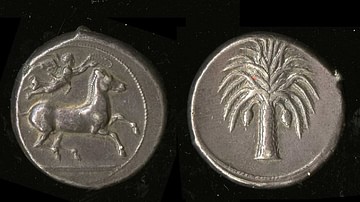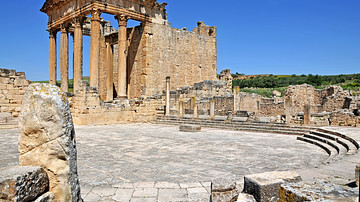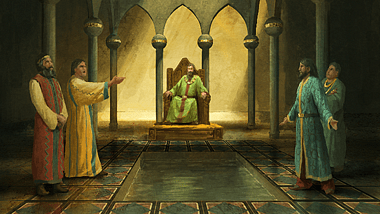
The government of Carthage was based on a system of elected officials accountable to a popular assembly. Unlike its founding city, Tyre in Phoenicia, Carthage did not have a monarchy but its politics was dominated by an aristocratic elite which was composed of competing clans and which held all important political, judicial, and military positions. As in other contemporary ancient cultures participation in political life and the popular assembly of the city was limited to those who held citizenship – indigenous and free males. Although the system was praised by such noted figures as Aristotle, some of the exact workings of the Carthaginian Government have remained elusive, a situation further confused by Greek and Roman writers using their own familiar terminology to describe the political institutions of Carthage.
Suffetes
The most powerful office in the Carthaginian government was held jointly by two magistrates elected annually known as suffetes (Latinized from the Punic sptm or shophetim and conventionally translated as 'judges'). These had replaced the initial system of monarchy sometime in the early 7th century BCE, and so their association with purely judicial matters may too have widened in political scope as the office evolved. It is also possible that there was only one suffete in the first century or so of the new system. From the 5th century BCE electing two suffetes becomes standard, one leading the armed forces of Carthage when at war and the other running the government at home. Greek and Roman sources indicate that the suffetes operated in collaboration with the senate and were also concerned with civil lawsuits. Wealth and family background seem to have been the two most important factors in being considered eligible for the role. The position of suffete continued to exist even when North Africa became a Roman province and is recorded at least until the 2nd century CE.
Senate
Carthage, even under its earliest form of monarchy, had a senate composed of influential citizens. These members were known as drm or the 'great ones' and held the position for life. Just how these senatorial members were selected is unknown, but it is likely they numbered between two and three hundred. They met in a building in the marketplace of Carthage but also sometimes at the temple of Eshmun on the Byrsa hill. The suffetes would consult the senate on government policy – military, diplomatic, and financial matters - and if the two sides disagreed, then a deciding vote would be held in the popular citizen's assembly (see below). Also, if one suffete was not in agreement then, again, the assembly would be consulted.
We know that the senate decided on declarations of war, whether or not to send additional armies to support generals in the field, punishments for commanders who failed in their objectives, and whether to accept peace terms offered by the enemy. The senate also sent representatives with Hannibal's army in Spain and Italy and signed the commander's peace treaty with Macedon in 215 BCE. However, it is also true that commanders often acted quite independently when campaigning across the Mediterranean, which led the Athenian politician Isocrates to state that Carthage was "ruled by an oligarchy at home, by a king in the field" (Miles, 146).
Senior Officials
Certain senators were selected to special commissions. Aristotle describes these as consisting of 5 members (hence their name 'pentarchies') who acted as judges in law courts, but Punic inscriptions only mention a 10-man commission responsible for religious sites and a 30-man commission which supervised taxation. In addition, there was a state treasury (mhsbm) headed by a single treasurer (rb) who is mentioned in one inscription as imposing penalties on those merchants who failed to pay customs duties. Other important state officials were the head of the priests (rb khnm) and the head of the army (rb mhnt), the latter very often also being a suffete in important conflicts.
All of these positions were elected, and all seem to have had a limited term of office, with the exception of the general who served for the duration of a war. These limitations were, no doubt, to prevent individuals from becoming too powerful, but it does not seem to have curbed corruption. Bribery - for votes, favourable decisions, and access to high positions – and embezzlement were such a problem that Hannibal's first task on being elected suffete was to improve the endemic corruption which was crippling the state's finances. Corruption was not helped by the absence of a salary for state officials, a fact which also meant that such positions were only open to those with a source of private income.
From the 5th century BCE a special branch of the senate composed of 104 members convened to assess the military performance of commanders on completion of their campaign. We imagine that the number is derived from 100 senators plus the two suffetes, the treasurer and the head of the priests. Senatorial membership of the council of 104 was for life. It was responsible for deciding the fate of generals and admirals who failed in a campaign with punishments ranging from fines to crucifixion.
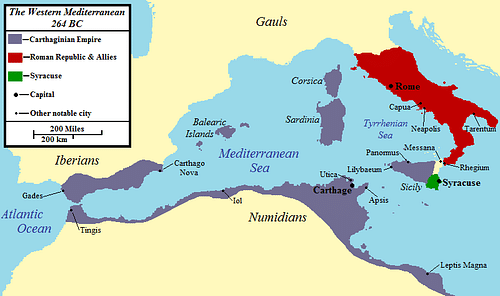
Another important group of officials was those administrators selected to govern the provinces controlled by Carthage. Allied cities such as Utica and Cadiz, and subject territories in North Africa were allowed a high degree of political autonomy except in military matters and foreign affairs. In return for Carthage's protection they did have to pay tribute in money, arms, and men for military service. Regional officials would have supervised this and collected such additional taxes as custom duties.
All of the key political positions in Carthaginian government were dominated by a ruling elite. This aristocracy was characterised and dominated by opposing families (mizreh), notably the Barcids and Magonids. Nevertheless, for enterprising citizens, especially rich merchants, there was the possibility to join this aristocracy as wealth was the overriding factor for success in politics. On the other hand, the traditional elite was composed of those who could claim descent to the colony's founding fathers, and it is clear that genealogy was an important consideration. This perhaps explains the rather confusing repetition of names from generation to generation resulting in literally hundreds of Hannos, Hamilcars, and Hannibals.
Assembly & Citizenship
The popular assembly of Carthage was known as the 'm (pron. ham) which translates as 'the people'. They met in the market square of the city, and their main powers were to vote on issues proposed by the suffetes and senate, and the election of officials, including the suffetes, chief priest and treasurer, and military commanders. Qualification to attend the assembly, beyond holding citizenship, and the system of voting are not known.
Citizenship was reserved for males from the city of Carthage. Women, slaves, and foreigners could not enjoy citizen status. There are some indicators in the historical record that there may have been a second tier of citizens composed of former slaves and foreign artisans. The existence of two levels of citizenship, though, continues to be debated amongst historians. Citizens were organised into memberships (mizrehim) or family clubs which were distinguishable from each other via their devotion to a specific god, the profession of their members, or perhaps even composed of those who had fought together in battle. Such memberships regularly bonded through shared banquets.
Citizens of allied cities in North Africa had a similar or equal status to their counterparts at Carthage in regards to civil law. The status of those who lived in the smaller settlements of the areas under Carthaginian control is not known. More certain is that the level of integration of peoples into the Carthaginian empire was quite low with the consequence that in times of peril, such as the Punic Wars with Rome, many cities defected to the Roman side. Carthage exploited its colonies but made no real efforts to foster a sense of belonging in their allied and conquered states, which meant that when Carthage fell, so too did its empire.
